warning light MAZDA MODEL MX-5 MIATA RF 2022 Workshop Manual
[x] Cancel search | Manufacturer: MAZDA, Model Year: 2022, Model line: MODEL MX-5 MIATA RF, Model: MAZDA MODEL MX-5 MIATA RF 2022Pages: 503, PDF Size: 42.06 MB
Page 193 of 503
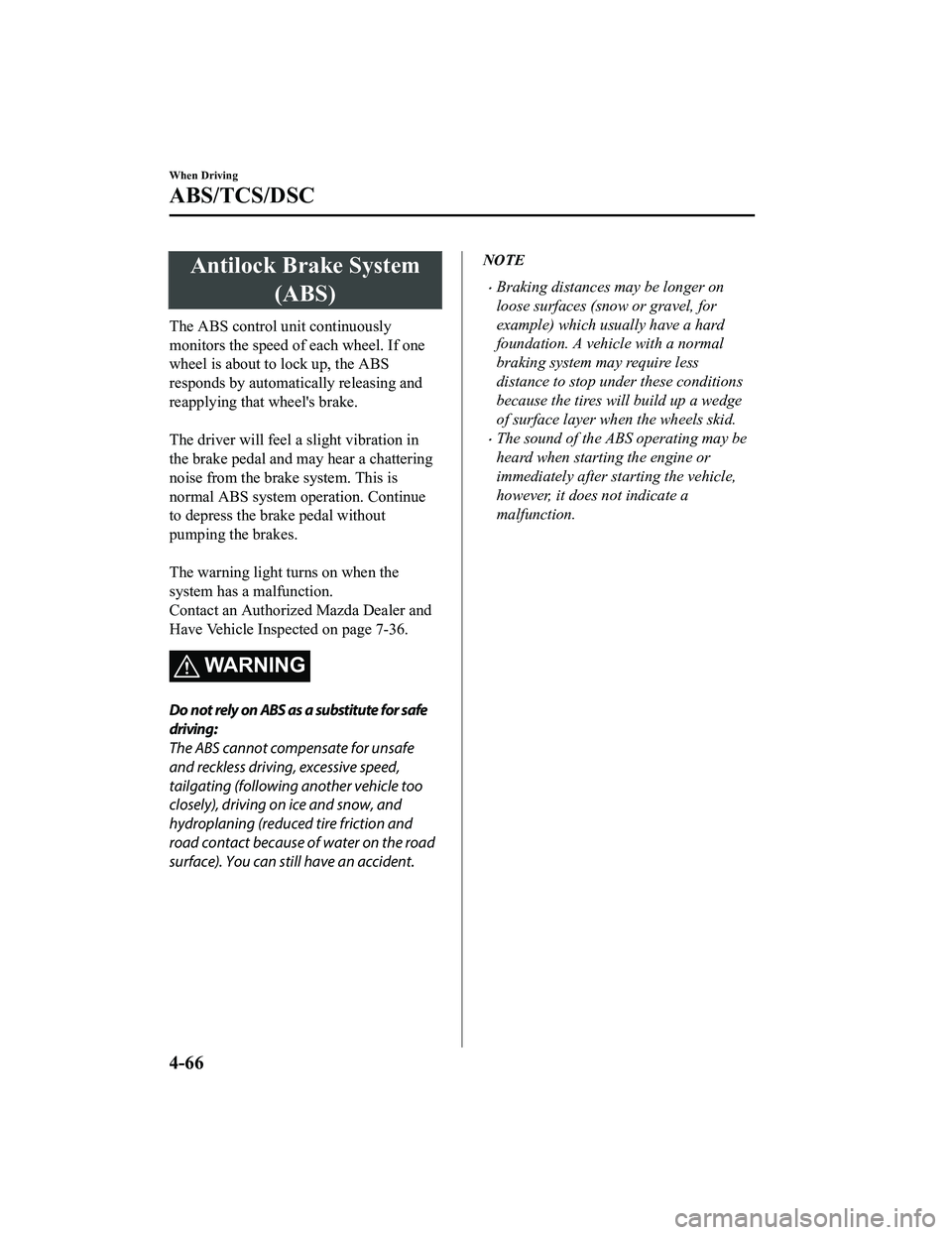
Antilock Brake System(ABS)
The ABS control unit continuously
monitors the speed of each wheel. If one
wheel is about to lock up, the ABS
responds by automatically releasing and
reapplying that wheel's brake.
The driver will feel a slight vibration in
the brake pedal and may hear a chattering
noise from the brake system. This is
normal ABS system operation. Continue
to depress the brake pedal without
pumping the brakes.
The warning light turns on when the
system has a malfunction.
Contact an Authorized Mazda Dealer and
Have Vehicle Inspected on page 7-36.
WA R N I N G
Do not rely on ABS as a substitute for safe
driving:
The ABS cannot compensate for unsafe
and reckless driving, excessive speed,
tailgating (following another vehicle too
closely), driving on ice and snow, and
hydroplaning (reduced tire friction and
road contact because of water on the road
surface). You can still have an accident.
NOTE
ï‚·Braking distances may be longer on
loose surfaces (snow or gravel, for
example) which usually have a hard
foundation. A vehicle with a normal
braking system may require less
distance to stop under these conditions
because the tires wi ll build up a wedge
of surface layer when the wheels skid.
ï‚·The sound of the ABS operating may be
heard when starting the engine or
immediately after starting the vehicle,
however, it does not indicate a
malfunction.
When Driving
ABS/TCS/DSC
4-66
MX-5_8KH8-EA-21K_Edition3_old 2021-11-10 13:10:56
Page 194 of 503
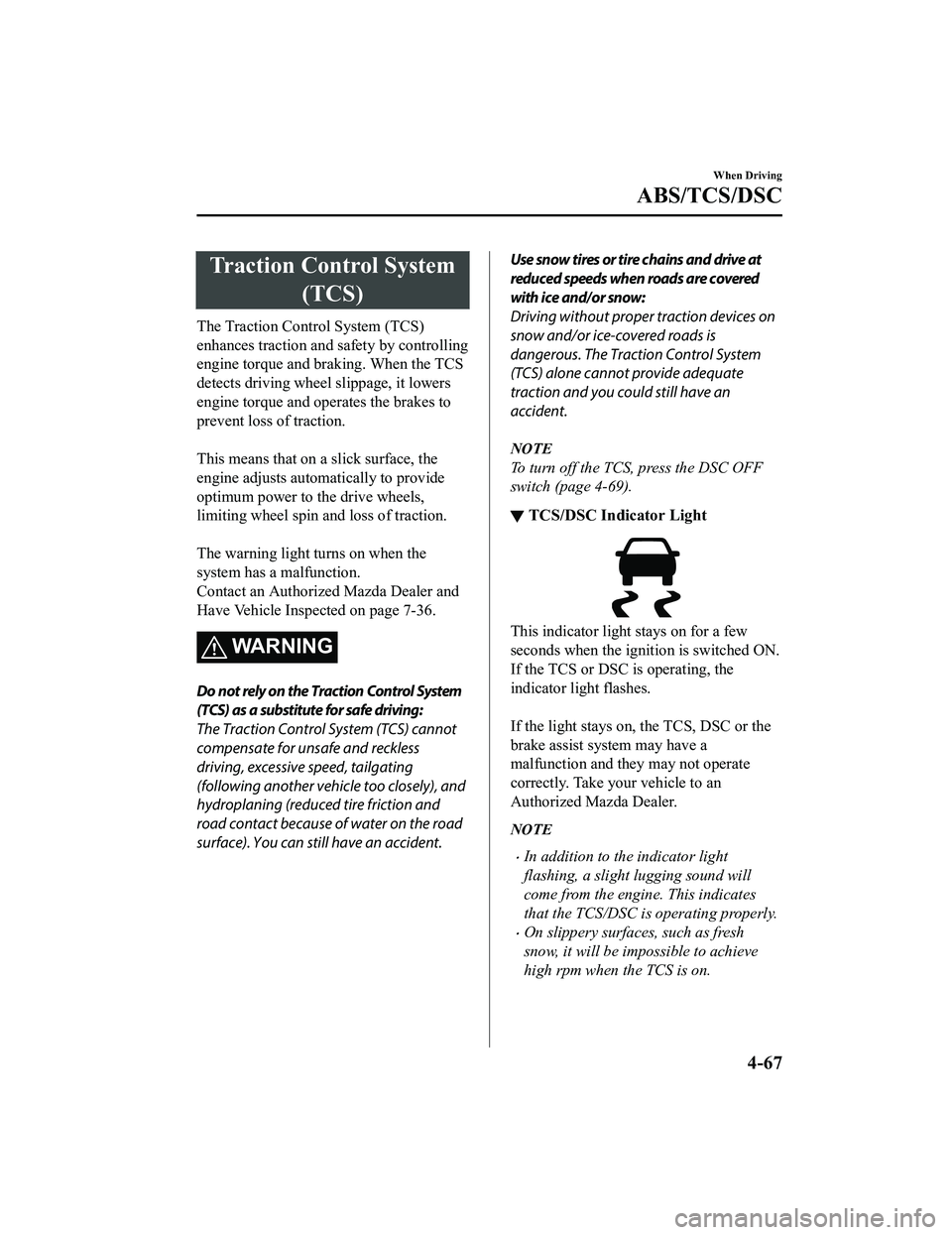
Traction Control System(TCS)
The Traction Control System (TCS)
enhances traction and safety by controlling
engine torque and braking. When the TCS
detects driving wheel slippage, it lowers
engine torque and operates the brakes to
prevent loss of traction.
This means that on a slick surface, the
engine adjusts automa tically to provide
optimum power to the drive wheels,
limiting wheel spin and loss of traction.
The warning light turns on when the
system has a malfunction.
Contact an Authorized Mazda Dealer and
Have Vehicle Inspected on page 7-36.
WARNING
Do not rely on the Traction Control System
(TCS) as a substitute for safe driving:
The Traction Control System (TCS) cannot
compensate for unsafe and reckless
driving, excessive speed, tailgating
(following another vehicle too closely), and
hydroplaning (reduced tire friction and
road contact because of water on the road
surface). You can still have an accident.
Use snow tires or tire chains and drive at
reduced speeds when roads are covered
with ice and/or snow:
Driving without proper traction devices on
snow and/or ice-covered roads is
dangerous. The Traction Control System
(TCS) alone cannot provide adequate
traction and you co uld still have an
accident.
NOTE
To turn off the TCS, press the DSC OFF
switch (page 4-69).
â–¼ TCS/DSC Indicator Light
This indicator light stays on for a few
seconds when the ignition is switched ON.
If the TCS or DSC is operating, the
indicator light flashes.
If the light stays on, the TCS, DSC or the
brake assist system may have a
malfunction and they may not operate
correctly. Take your vehicle to an
Authorized Mazda Dealer.
NOTE
ï‚·In addition to the indicator light
flashing, a slight lugging sound will
come from the engine. This indicates
that the TCS/DSC is operating properly.
ï‚·On slippery surfaces, such as fresh
snow, it will be impossible to achieve
high rpm when the TCS is on.
When Driving
ABS/TCS/DSC
4-67
MX-5_8KH8-EA-21K_Edition3_old
2021-11-10 13:10:56
Page 195 of 503

Dynamic Stability Control(DSC)
The Dynamic Stability Control (DSC)
automatically controls braking and engine
torque in conjunction with systems such as
ABS and TCS to help control side slip
when driving on slippery surfaces, or
during sudden or evasive maneuvering,
enhancing vehicle safety.
Refer to ABS (page 4-66) and TCS (page
4-67).
DSC operation is possible at speeds
greater than 20 km/h (12 mph).
The warning light turns on when the
system has a malfunction.
Contact an Authorized Mazda Dealer and
Have Vehicle Inspected on page 7-36.
WA R N I N G
Do not rely on the Dynamic Stability
Control as a substitute for safe driving:
The Dynamic Stability Control (DSC)
cannot compensate for unsafe and reckless
driving, excessive speed, tailgating
(following another vehicle too closely), and
hydroplaning (reduced tire friction and
road contact because of water on the road
surface). You can still have an accident.
CAUTION
 The DSC may not operate correctly
unless the following are observed:
 Use tires of the correct size
specified for
your Mazda on all 4 wheels.
 Use tires of the same manufacturer,
brand and tread pattern on all 4
wheels.
 Do not mix worn tires.
 The DSC may not operate correctly when
tire chains are used or a temporary spare
tire is installed because the tire diameter
changes.
â–¼ TCS/DSC Indicator Light
This indicator light stays on for a few
seconds when the ignition is switched ON.
If the TCS or DSC is operating, the
indicator light flashes.
If the light stays on, the TCS, DSC or the
brake assist system may have a
malfunction and they may not operate
correctly. Take your vehicle to an
Authorized Mazda Dealer.
When Driving
ABS/TCS/DSC
4-68
MX-5_8KH8-EA-21K_Edition3_old
2021-11-10 13:10:56
Page 199 of 503
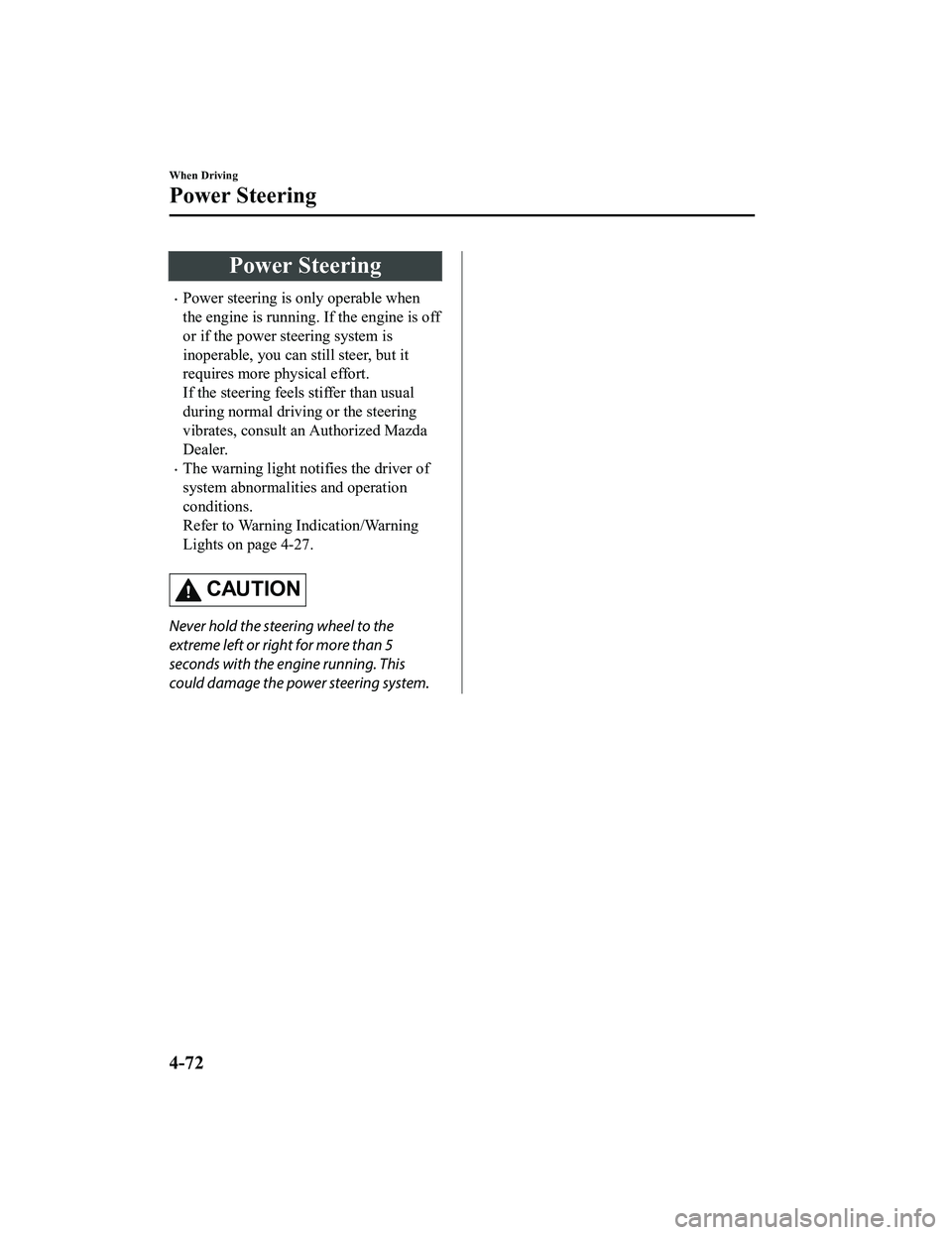
Power Steering
ï‚·Power steering is only operable when
the engine is running. If the engine is off
or if the power steering system is
inoperable, you can still steer, but it
requires more physical effort.
If the steering feels stiffer than usual
during normal driving or the steering
vibrates, consult an Authorized Mazda
Dealer.
ï‚·The warning light notifies the driver of
system abnormalities and operation
conditions.
Refer to Warning Indication/Warning
Lights on page 4-27.
CAUTION
Never hold the steering wheel to the
extreme left or right for more than 5
seconds with the engine running. This
could damage the power steering system.
When Driving
Power Steering
4-72
MX-5_8KH8-EA-21K_Edition3_old2021-11-10 13:10:56
Page 200 of 503
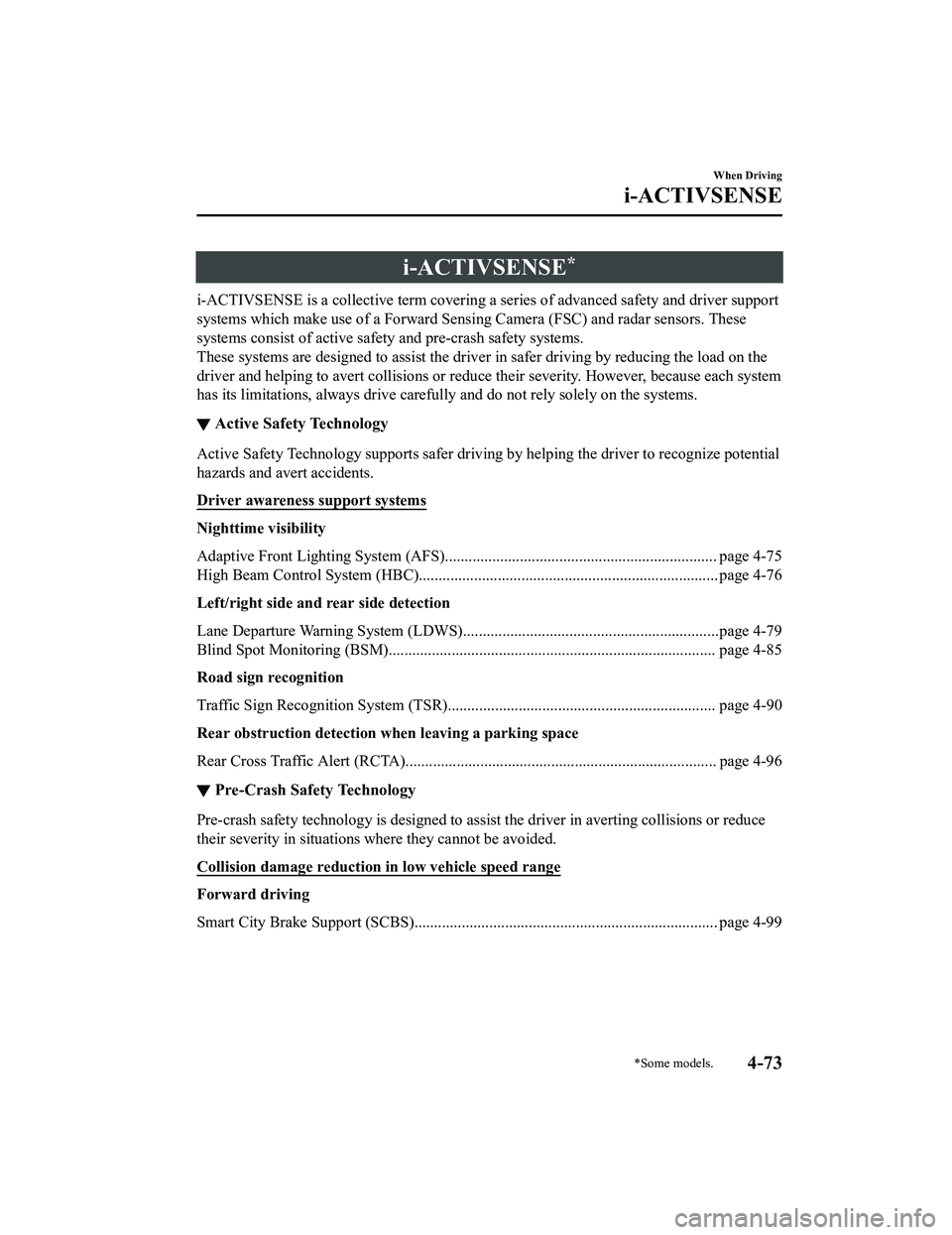
i-ACTIVSENSE*
i-ACTIVSENSE is a collective term covering a series of advanced safety and driver support
systems which make use of a Forward Sensing Camera (FSC) and radar sensors. These
systems consist of active safety and pre-crash safety systems.
These systems are designed to assist the driver in safer driving by reducing the load on the
driver and helping to avert collisions or reduce their severity. However, because each system
has its limitations, always drive carefull y and do not rely solely on the systems.
â–¼Active Safety Technology
Active Safety Technology supports safer driving
by helping the driver to recognize potential
hazards and avert accidents.
Driver awareness support systems
Nighttime visibility
Adaptive Front Lighting System (AFS)..................................................................... page 4-75
High Beam Control System (HBC)............................................................................ page 4-76
Left/right side and rear side detection
Lane Departure Warning Syst em (LDWS).................................................................page 4-79
Blind Spot Monitoring (BSM)................................................................................... page 4-85
Road sign recognition
Traffic Sign Recognition System (TSR). ................................................................... page 4-90
Rear obstruction detection when leaving a parking space
Rear Cross Traffic Alert (RCTA)............................................................................... page 4-96
â–¼ Pre-Crash Safety Technology
Pre-crash safety technology is designed to assi
st the driver in averting collisions or reduce
their severity in situations where they cannot be avoided.
Collision damage reduction in low vehicle speed range
Forward driving
Smart City Brake Support (SCBS)............................................................................. page 4-99
When Driving
i-ACTIVSENSE
*Some models.4-73
MX-5_8KH8-EA-21K_Edition3_old 2021-11-10 13:10:56
Page 202 of 503

Adaptive Front Lighting System (AFS)*
The adaptive front lighting system (AFS) automatically adjusts the headlight beams to the
left or right in conjunction with the operation of the steering wheel after the headlights have
been turned on.
A system malfunction or operation conditions are indicated by a warning.
Refer to Contact Authorized Mazda Dealer and Have Vehicle Inspected on page 7-36.
NOTE
The Adaptive Front Lighting System (AFS) func tion can be switched to operable/inoperable
using the personalization function.
Refer to the Settings section in the Mazda Connect Owner's Manual.
When Driving
i-ACTIVSENSE
*Some models.4-75
MX-5_8KH8-EA-21K_Edition3_old 2021-11-10 13:10:56
Page 203 of 503
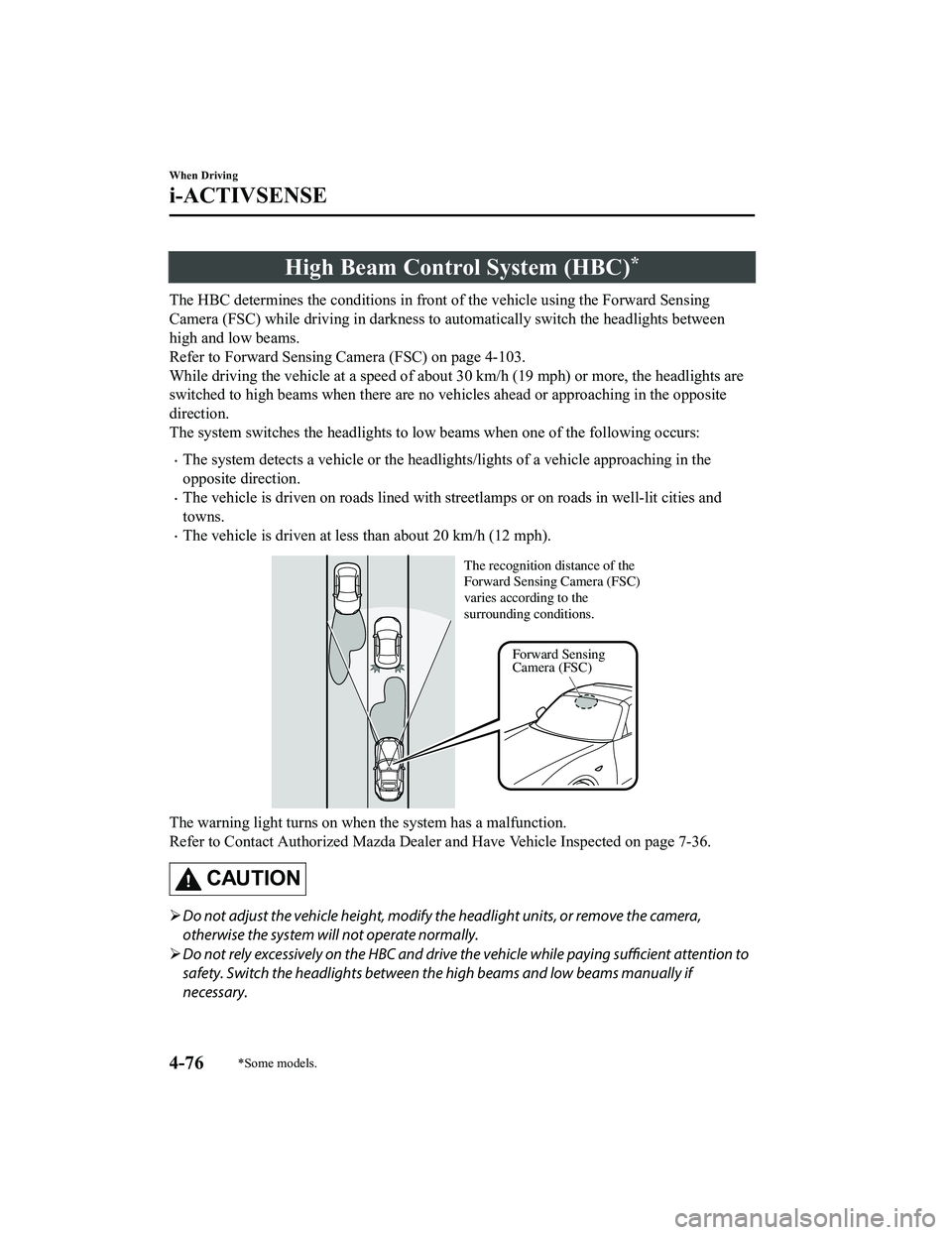
High Beam Control System (HBC)*
The HBC determines the conditions in front of the vehicle using the Forward Sensing
Camera (FSC) while driving in darkness to automatically switch the headlights between
high and low beams.
Refer to Forward Sensing Camera (FSC) on page 4-103.
While driving the vehicle at a speed of about 30 km/h (19 mph) or more, the headlights are
switched to high beams when there are no vehicles ahead or approaching in the opposite
direction.
The system switches the headlights to low beams when one of the following occurs:
ï‚·The system detects a vehicle or the headlights/lights of a vehicle approaching in the
opposite direction.
ï‚·The vehicle is driven on roads lined with st reetlamps or on roads in well-lit cities and
towns.
ï‚·The vehicle is driven at less than about 20 km/h (12 mph).
Forward Sensing
Camera (FSC)
The recognition distance of the
Forward Sensing Camera (FSC)
varies according to the
surrounding conditions.
The warning light turns on when
the system has a malfunction.
Refer to Contact Authorized Mazda Dealer and Have Vehicle Inspected on page 7-36.
CAUTION
 Do not adjust the vehicle height, modify th e headlight units, or remove the camera,
otherwise the system will not operate normally.
 Do not rely excessively on the HBC and drive the vehicle while paying sufficient attention to
safety. Switch the headlights between the high beams and low beams manually if
necessary.
When Driving
i-ACTIVSENSE
4-76*Some models.
MX-5_8KH8-EA-21K_Edition3_old 2021-11-10 13:10:56
Page 206 of 503

Lane Departure Warning System (LDWS)*
The LDWS notifies the driver that the vehicle may be deviating from its lane.
The system detects the white or yellow lines on the traffic lane using the Forward Sensing
Camera (FSC) and if it determines that the vehi cle may be deviating from its lane, it notifies
the driver by flashing the LDWS warning light and activating the LDWS warning beep, and
by the multi-information display (vehic les with multi-information display).
Use the LDWS when you drive the vehicle on roads with white or yellow lines.
Refer to Forward Sensing Camera on page 4-103.
Forward Sensing Camera
(FSC)
The warning light illuminates when the system has a malfunction.
Refer to Warning Indication/Warning Lights on page 4-27.
WARNING
Do not use the LDWS under the following conditions:
The system may not operate adequately accordin g to the actual driving conditions, resulting
in an accident.
 Driving on roads with tight curves.
 Driving under bad weather conditions (rain, fog, and snow).
When Driving
i-ACTIVSENSE
*Some models.4-79
MX-5_8KH8-EA-21K_Edition3_old 2021-11-10 13:10:56
Page 207 of 503

The functions of the LDWS have limitations:
Always stay on course using the steering wheel and drive with care. The system is not
designed to compensate for a driver’s lack of caution and if you rely too much on the LDWS it
could lead to an accident. The driver is res ponsible for assuring lane changes and other
maneuvers. Always pay attention to the direction in which the vehicle is traveling and the
vehicle’s surroundings.
CAUTION
Do not modify the suspension. If the vehicle height or the damping force of the suspensions is
changed, the LDWS may not operate correctly.
NOTE
ï‚·If your vehicle deviates from its traffi c lane, the LDWS operates (warning sound and
indicator light). Steer the vehicle adequately to drive the vehicle to the center of the lane.
ï‚·When the turn signal lever is operated for a lane change, the LDWS warning is
automatically canceled. The LDWS warning becomes operable when the turn signal lever
is returned and the system detects the white or yellow lines.
ï‚·If the steering wheel, accelerator pedal, or brake pedal is operated abruptly and the
vehicle moves close to a white or yellow line, the system determines that the driver is
making a lane change and the LDWS warning is automatically canceled.
ï‚·The LDWS may not operate during the period immediately after the vehicle has deviated
from its lane and the LDWS has operated, or the vehicle deviates from its lane repeatedly
within a short period of time.
ï‚·The LDWS does not operate if it does not dete ct the white or yellow lines of the traffic
lane.
ï‚·Under the following conditions, the LDWS may not be able to detect white or yellow lines
correctly and the LDWS may not operate correctly.
ï‚·If an object placed on the dashboard is reflected in the windshield and picked up by the
camera.
ï‚·Heavy luggage is loaded in the luggage compartment the vehicle is inclined.
ï‚·The tire pressures are not adjusted to the specified pressure.
ï‚·When the vehicle is driven on the entry and exit to or from the rest area or tollgate of a
highway.
ï‚·The white or yellow lines are less visible because of dirt or paint flaking.
ï‚·The vehicle ahead is running near a white or yellow line and the line is less visible.
ï‚·A white or yellow line is less visible because of bad weather (rain, fog, or snow).
ï‚·The vehicle is driven on a temporary lane or section with a closed lane due to
construction.
When Driving
i-ACTIVSENSE
4-80
MX-5_8KH8-EA-21K_Edition3_old 2021-11-10 13:10:56
Page 209 of 503

â–¼When the System Operates
1. The system goes on operation standby
when the LDWS OFF switch is
pressed and the LDWS OFF indicator
light in the instrument cluster turns off.
2. Drive the vehicle in the center of the
driving lane while the LDWS OFF
indicator light is turned off. The
system becomes operational when all
of the following conditions are met.
ï‚·The vehicle is driven in the center of
the driving lane with the white or
yellow lines on the left and right
sides, or on either side.
ï‚·The vehicle speed is about 70 km/h
(44 mph) or faster.
ï‚·The vehicle is driven on a straight
road or road with gentle curves.
The LDWS does not operate in the
following cases:
ï‚·The system cannot detect white or
yellow lines.
ï‚·The vehicle speed is less than about
65 km/h (40 mph).
ï‚·The vehicle is making a sharp turn.
ï‚·The vehicle is making a curve at an
inadequate speed.
NOTE
ï‚·The LDWS does not operate until the
system detects a white or yellow line on
either the left or right.
ï‚·When the system detects a white or
yellow line on one side only, the system
will activate the warning only when the
vehicle deviates on the side where the
white or yellow line is being detected.
ï‚·The distance and warning sensitivity
(likelihood of a warning) which the
system uses to determine the possibility
of a lane departure can be changed.
Refer to the Settings section in the
Mazda Connect Owner's Manual.
When Driving
i-ACTIVSENSE
4-82
MX-5_8KH8-EA-21K_Edition3_old 2021-11-10 13:10:56